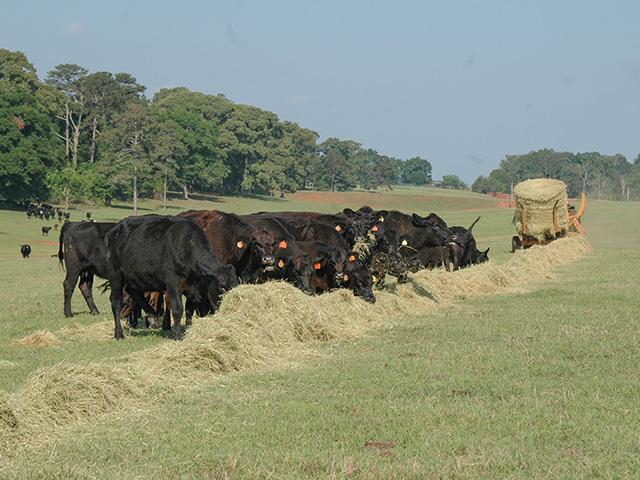Hay Testing Pays
Feed the Right Hay to the Right Cows
Dennis Pearson is serious about his hay, with good reason. "Thirty percent of our income comes from hay sales," the Warrenton, Virginia, producer explained. Equally as important, if not more so, it helps fuel his 80-cow purebred Angus herd. He tests the rolls he feeds, as well as the small square bales he sells to customers for their horses.
Pearson's county agent, Tim Mize, is all for that kind of detailed approach to hay management. "All hay is not the same. It is like EPDs (expected progeny differences). You can't tell by looking at a bull what his EPDs are. And if you just look at hay, it won't tell you where it is in quality and how you need to feed it."
Texas A&M Extension beef specialist Jason Banta agrees. "If you test, you know which cutting or lot to feed to which class of cattle."
For example, if cows are dry, assuming they weigh around 1,300 pounds, they can get by with 55% total digestible nutrients (TDN) and a little over 8.5% crude protein (CP). If they calved and are hitting peak lactation, that goes up to 61% TDN and 12.5% CP. Feed them all the same hay, and somebody is either getting short-changed or overfed. With a hay analysis in hand, however, you know who should get the better hay.
At Pearson's Soldiers' Hill Angus Farm, the orchard grass, fescue and bluegrass hay he grows runs anywhere from 58% to 62% TDN and 8% to 14% CP. The highest-quality bales go to growing cattle, which include weaned calves, replacement heifers and young bulls. He supplements them lightly with grain, at less than 1% of their body weight per head, per day. Mid-quality hay goes to lactating fall-calving cows, so they'll be in good condition for rebreeding. The lessor-quality hay goes to spring calvers, which are dry during the winter when most stored forage is fed.
FORAGE TESTS NOT ALL ALIKE
P[L1] D[0x0] M[300x250] OOP[F] ADUNIT[] T[]
Mize handles Pearson's forage tests, reporting back quality levels. Pearson takes the hay samples in, and Mize sends them to a commercial lab. Typically, they get the near-infrared reflectance spectroscopy (NIR) analysis done, rather than the more expensive wet chemistry analysis, which takes longer.
The basic analysis gives dry matter, CP, adjusted crude protein, neutral detergent fiber (NDF) digestibility and mineral content. Estimated net energy for maintenance (NEM) and net energy for gain (NEG) are also included and are useful for growing animals, like stocker steers.
Mize says TDN is in the report but as an estimated number rather than an exact measurement. "Producers are familiar with TDN, and it works well for beef cows."
If you're buying hay rather than putting up your own, Texas A&M's Banta says it shouldn't be a problem to get it tested before you buy.
"Most hay dealers are willing if you tell them you'll pay for it and share the results with them whether you buy it or not," he says.
WEIGHT AND DENSITY MATTER
Whether you're buying hay or growing your own, weight of the bales is another big variable best not left to guessing. Round bales are usually described by width times diameter. Density also plays into the equation and can make a big difference in actual cost of hay and/or how often you have to feed it.
On Pearson's operation, it is moisture that makes the difference. His 4-by-5-foot dry bales usually weigh around 800 pounds a roll, while his wet wrapped hay (baleage) averages 1,600 pounds. Because of the variation in weight, even in dry hay, Banta recommends buying per ton, rather than per roll. If a 1,100-pound roll and an 880-pound roll are both priced the same, you'll be paying less per ton for the heavier roll and more per ton for the lighter roll.
TAKEAWAY TESTING TIPS
Thankfully, testing hay is a chore that's pretty basic and not overly expensive.
It's always a good idea to visit a nutritionist or rations expert before sending in a hay test, to be sure you know what you're looking for and which tests are most appropriate. That said, consider these four simple steps.
1. Get a hay probe. Many county Extension offices have one you can probably borrow.
2. Take a sample from the center of the bale. Go in from the rounded side rather than the top.
3. Sample around 10% of the bales from a lot, meaning same field, and cut at the same time.
4. Mix the cores in a zip-close bag, label it, and give it to the person sending off samples for you -- or send it yourself.
(c) Copyright 2022 DTN, LLC. All rights reserved.






